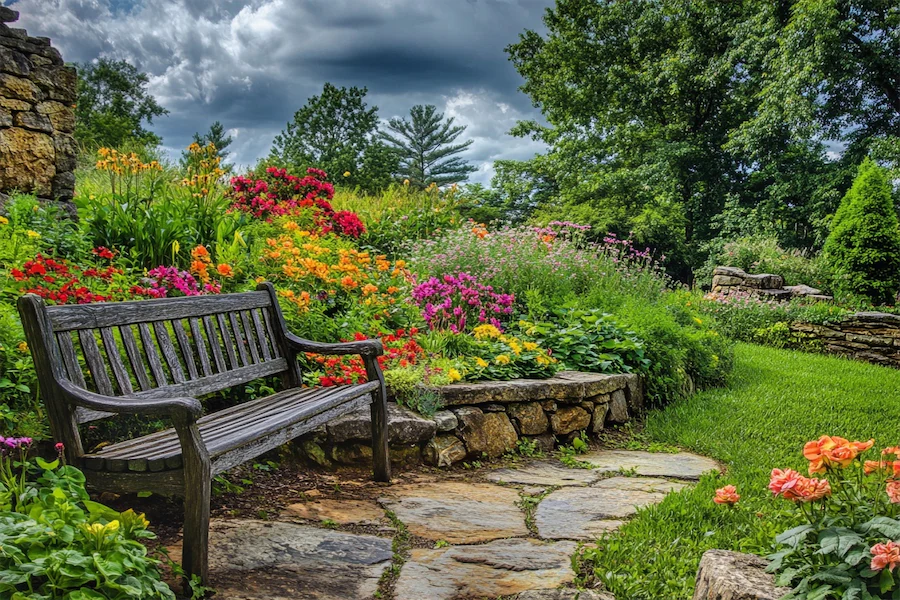A rock garden, also known as a rockery or alpine garden, is a designed landscape feature that combines rocks, stones, and carefully selected plants to create a naturalistic and aesthetically pleasing environment. These gardens often emulate mountainous terrains or dry landscapes, showcasing the beauty of rugged stone formations complemented by resilient plant species.
History and Origins of Rock Gardens
The concept of rock gardens originated in Asia, particularly in Japanese and Chinese gardening traditions, where rocks symbolize permanence and stability. In the late 19th and early 20th centuries, rock gardening gained popularity in Europe and North America, influenced by the fascination with alpine plants and the desire to replicate their natural habitats. Gardeners began constructing rockeries to showcase these unique plants, leading to the development of specialized designs and techniques.
Key Features of Rock Gardens
Rock gardens are characterized by several distinctive elements:
- Stone Selection and Placement: Utilizing a variety of rocks, from large boulders to small pebbles, arranged thoughtfully to mimic natural outcrops and create visual interest. The choice of stone should harmonize with the surrounding environment and the garden’s overall design.
- Plant Selection: Incorporating plants that thrive in well-drained, rocky soils, such as succulents, alpines, and certain perennials. These plants are often drought-tolerant and adapted to harsh conditions, making them suitable for rock gardens.
- Elevation and Terracing: Creating varying heights and slopes to add depth and dimension, allowing for diverse planting niches and enhancing the garden’s natural appearance. Terracing can also aid in drainage and prevent soil erosion.
- Gravel and Mulch: Using gravel or small stones as ground cover to suppress weeds, retain moisture, and provide a cohesive look. This also helps in maintaining soil temperature and reducing evaporation.
Applications of Rock Garden Design
Rock gardens serve multiple purposes:
- Aesthetic Appeal: Offering a unique and attractive landscape feature that stands out from traditional gardens, adding texture and contrast.
- Low Maintenance Landscaping: Once established, rock gardens require minimal upkeep, as the plants are typically hardy and the design reduces the need for frequent watering.
- Erosion Control: Stabilizing slopes and preventing soil erosion through strategic placement of rocks and deep-rooted plants.
- Habitat Creation: Providing habitats for various wildlife, including insects, birds, and small mammals, contributing to local biodiversity.
Considerations When Creating a Rock Garden
When planning a rock garden, consider the following:
- Site Selection: Choose a location with good drainage and adequate sunlight, as most rock garden plants prefer these conditions. Avoid low-lying areas prone to waterlogging.
- Soil Preparation: Amend the soil with sand or grit to improve drainage, and remove any weeds or grass to prevent competition with desired plants. A well-draining soil mix is crucial for the health of rock garden plants.
- Rock Arrangement: Position rocks to emulate natural formations, burying a portion of each rock to anchor it and create a more authentic look. Consider the size, shape, and color of the rocks to achieve a balanced composition.
- Plant Selection: Opt for native or well-adapted species that can withstand the local climate and soil conditions. Group plants with similar water and light needs together to ensure optimal growth.
- Maintenance: Regularly check for weeds, manage plant growth to prevent overcrowding, and replenish gravel or mulch as needed to maintain the garden’s appearance and health.
Conclusion
Rock gardens offer a harmonious blend of natural stone and resilient plant life, creating serene and enduring landscapes. By understanding their historical context, key features, and practical applications, you can design and implement a rock garden that enhances your outdoor space with beauty and ecological benefits.
